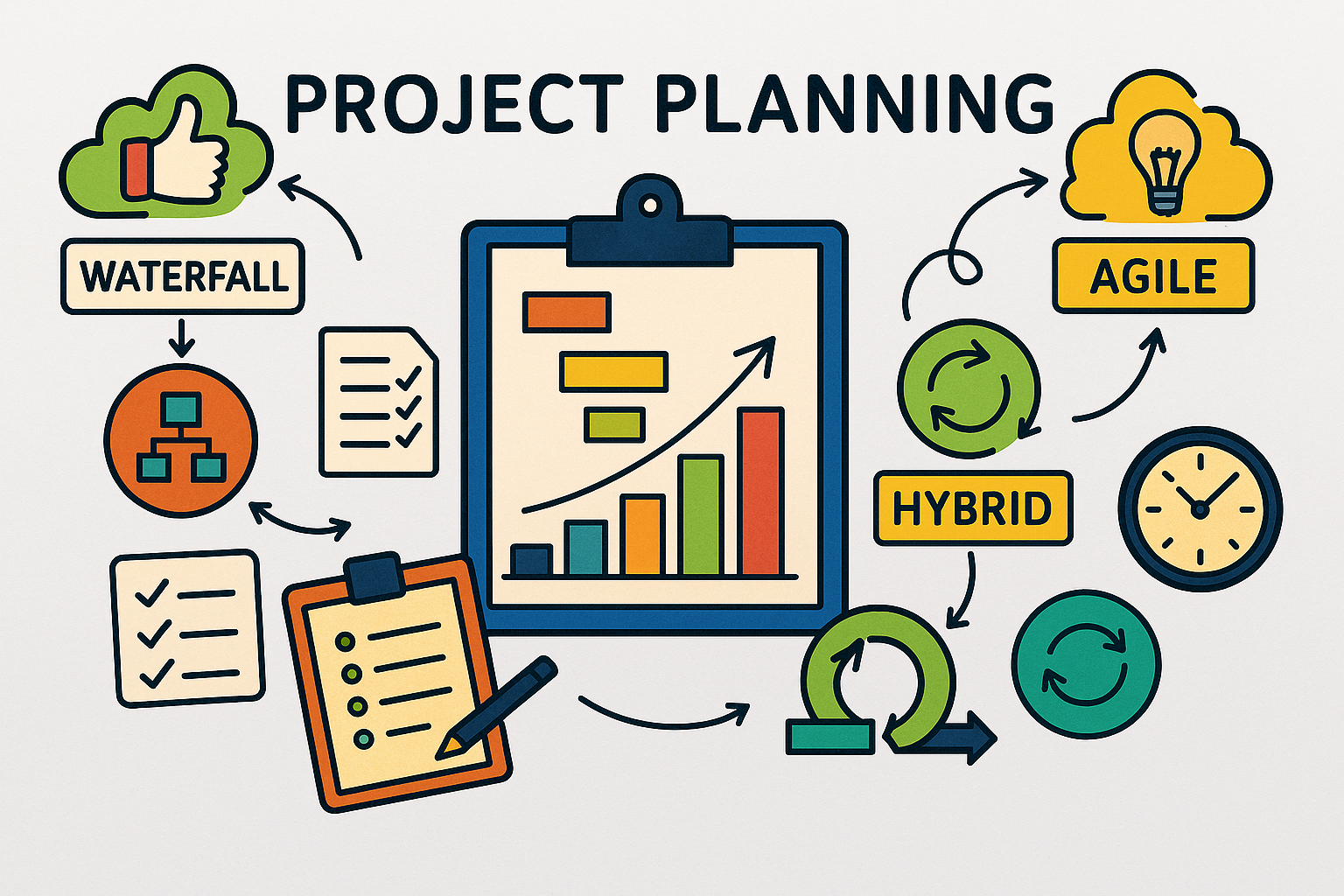Project planning isn’t about producing immaculate Gantt charts or speaking fluent methodology. It’s about helping people deliver the right outcomes, earlier, with fewer surprises. In professional services—where billable time, client trust and regulatory scrutiny meet—practicality beats theory every time.
In this article, I’ll explore Waterfall, Agile and the increasingly popular Hybrid approach. I’ll keep it jargon‑free and focused on what works in real life.
In my view, almost every project benefits from a hybrid approach; Waterfall for the framework, Agile for delivery.
If you’ve ever felt caught between rigid stage plans and vague stand‑ups, this post is definitely for you.
Planning Is More Than a Document
Before diving into methodologies, think of planning in three layers:
- Direction: What we’re trying to achieve and why it matters (outcomes, benefits, success measures).
- Delivery: How we’ll get there (scope, dependencies, people, estimates, risks).
- Discipline: How we’ll stay on track (governance, reporting, decisions, change control).
A good plan touches all three. Tools help, but they’re secondary. A clear outcome, a believable path and a way to make timely decisions beat any software.
Waterfall: Structured and Sequential
Waterfall is a staged, step‑by‑step approach. You define the outcomes and scope, design the solution, build it, test it and then go live. Each stage has exit criteria and stage gates. You can’t proceed to through the stage gate until the exit criteria has been met.
It’s ideal when work has natural dependencies and the cost of rework is high. Think data migrations, integrations with regulated systems or anything involving fixed lead times.
Strengths
- Clear, stable requirements
- Compliance and audit needs
- Heavy dependencies and big‑bang events
Limitations
- Poor fit for high‑discovery work
- Late feedback can be costly
- Stakeholders may disengage without visible progress
Agile: Iterative and Adaptive
Agile delivers value in small increments, with frequent feedback and the flexibility to adapt as you learn. Sprints, backlogs and stand‑ups are just mechanics—the real benefit is short feedback loops and responsiveness.
Strengths
- Great for discovery and innovation
- Keeps stakeholders engaged through visible progress
- Reduces risk by validating early
Limitations
- Harder where external approvals dominate
- Can frustrate organisations needing firm dates
- Risks becoming chaotic if discipline is missing
The Hybrid Sweet Spot
Most projects mix predictable and uncertain work. That’s why in my view Hybrid wins. Use a Waterfall framework to give sponsors confidence—clear phases, gates and milestone dates—and run Agile delivery inside those phases to bring value forward and reduce risk.
Think of it as two zoom levels:
- Zoomed out: Milestone map, governance, decision points
- Zoomed in: Short sprints, demos, visible backlog
Hybrid respects reality: some things must happen in sequence; others should be iterated to get right.
A Practical 8‑Step Approach to Hybrid Planning
- Clarify outcomes and benefits – Write 3–5 outcome statements anyone can understand.
- Map immovable dependencies – Identify hard dates like vendor slots or regulatory approvals.
- Slice deliverables into increments – Find the smallest version that delivers real value.
- Draft your milestone map – 4–7 big milestones with clear exit criteria.
- Set your sprint cadence and define “Done” – Avoid ambiguity.
- Stand up lightweight governance – Enough structure to steer, not stifle.
- Plan in waves – Detail the next 4–6 weeks; sketch the next quarter.
- Choose tools you’ll actually use – Simplicity beats novelty.
What to Include (and Leave Out)
Must‑haves
- One‑page summary for sponsors
- Milestone map with exit criteria
- Near‑term sprint backlog
- RAID log that drives action
- Communication plan
Leave out
- Ten pages of methodology boilerplate
- Over‑engineered Gantt charts
- Uncosted “stretch goals”
Deciding What’s Waterfall vs Agile
Ask these questions for each deliverable:
- Does it have hard external dependencies? → Waterfall controls
- Can we slice it and get feedback early? → Agile delivery
- Would late feedback be expensive? → Bring it forward as a prototype
- Is it highly regulated? → More Waterfall, but still iterate safely
Reporting That Leaders Actually Read
Keep it short and useful:
- RAG on outcomes, not just activity
- What changed since last time
- Top three risks/issues and actions
- Decisions needed and by whom
- Next two weeks at a glance
Common Pitfalls
- Starting with tools instead of habits
- Treating Agile as “no plan”
- Designing perfect processes that ignore culture
- Stage gates that don’t gate anything
- Parallelising everything without checking dependencies
Closing Thoughts
The best plans are the ones teams actually use and leaders trust. A Waterfall framework offers confidence and coordination; Agile delivery brings learning and value forward. Combine them deliberately and you’ll get earlier benefits, fewer surprises and a calmer go‑live.
If you’d like a quick, structured sense‑check before you launch, or a way to course‑correct mid‑journey, download my Ultimate Project Health Check Tool. It takes less than an hour and pinpoints the improvements that will make the biggest difference.
Need hands‑on help with planning your next project? Get in touch today. I’d be happy to discuss how I can make your plan practical, achievable and stress‑free.
Paul Every
Assurify Consulting, Jersey

I specialise in project assurance, governance, PMO and ‘technology enabled change’; helping clients obtain greater value from their investments in projects, programme, portfolios and technology.
My clients choose to work with me because I am a pragmatist; I recommend and deliver solutions that can be easily implemented. You also get what you see – I will define what you need, then it will be me who is on site helping you deliver your change.





Leave a Reply